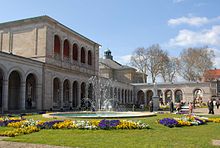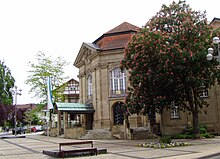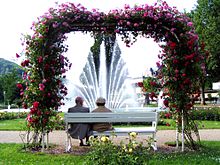| Revision as of 04:09, 20 June 2017 editMagic links bot (talk | contribs)Bots291,110 editsm Replace magic links with templates per local RfC and MediaWiki RfC← Previous edit | Revision as of 15:12, 23 June 2017 edit undo84.170.28.81 (talk) added chapter "Great spas of europe"Next edit → | ||
| Line 58: | Line 58: | ||
| File:Kissingen-Bahnhof-1875.jpg|mini|Bad Kissingen with its new station (left), about 1875 | File:Kissingen-Bahnhof-1875.jpg|mini|Bad Kissingen with its new station (left), about 1875 | ||
| </gallery> | </gallery> | ||
| == Great Spas of Europe == | |||
| Bad Kissingen was one of the leading spas in the 19th and early 20th century, which in German are called "Weltbad". They differ from other spa resorts mainly through the following criteria: | |||
| * Entertainment: A "Weltbad" offered many opportunities for the spa guests to spend their free time, such as exercise and sports, trips to the surroundings, theater and concert, library and games. | |||
| * Guests: The "Weltbad" was attractive to guests from all five continents. Particular attention was paid to prominent visitors, who attracted more visitors, especially from nobility and upscale middle class. | |||
| * Infrastructure and supply: Despite the small number of inhabitants, a "Weltbad" offered the guests all the contemporary comfort, which was not even common in all major cities. These include good transport connections, communication facilities (such as telegraphy and telephone on the latest state of the art), luxury goods offer, differentiated hotel and gastronomy as well as state-of-the-art technology for energy supply, water supply and sanitation<ref>https://www.badkissingen.de/de/aktivitaeten/museen-obere-saline/weltbad-kissingen/index.html</ref>. | |||
| Bad Kissingen and several other of these traditional spa baths want to become a UNESCO World Heritage site under the name "Great Spas of Europe". | |||
| ==Geography== | ==Geography== | ||
Revision as of 15:12, 23 June 2017
For the district, see Bad Kissingen (district).Town in Bavaria, Germany
| Bad Kissingen | |
|---|---|
| Town | |
 Bad Kissingen viewed from Bodenlaube ruins Bad Kissingen viewed from Bodenlaube ruins | |
 Coat of arms Coat of arms | |
Location of Bad Kissingen within Bad Kissingen district
 | |
  | |
| Coordinates: 50°12′N 10°4′E / 50.200°N 10.067°E / 50.200; 10.067 | |
| Country | Germany |
| State | Bavaria |
| Admin. region | Unterfranken |
| District | Bad Kissingen |
| Subdivisions | 9 Stadtteile |
| Government | |
| • Lord mayor | Kay Blankenburg (SPD) |
| Area | |
| • Total | 69.42 km (26.80 sq mi) |
| Elevation | 220 m (720 ft) |
| Population | |
| • Total | 23,245 |
| • Density | 330/km (870/sq mi) |
| Time zone | UTC+01:00 (CET) |
| • Summer (DST) | UTC+02:00 (CEST) |
| Postal codes | 97688 |
| Dialling codes | 0971 |
| Vehicle registration | KG |
| Website | www.badkissingen.de |






Bad Kissingen is a spa town in the Bavarian region of Lower Franconia and seat of the district Bad Kissingen. Situated to the south of the Rhön Mountains on the Franconian Saale river, it is one of the health resorts, which became famous as a "Weltbad" in the 19th century.
History
The town was first documented in the year 801 as chizzicha and was renowned above all for its mineral springs, which are recorded from as early as 823. Kissingen was first mentioned as "oppidum" (town) in 1279. The town developed to a spa in the 1500s and recorded its first official spa guest in 1520. Kissingen grew to be a fashionable resort in the 19th century, and was extended during the reign of Ludwig I of Bavaria. Crowned heads of state such as Empress Elisabeth of Austria, Tsar Alexander II of Russia and King Ludwig II of Bavaria, who bestowed the 'Bad' on Kissingen in 1883, were among the guests of the spa at this time. Other well-known visitors to the resort included author Leo Tolstoy and artist Adolph von Menzel.
On 10 July 1866 during the Mainfeldzug of the Austro-Prussian War, Kissingen was the site of fierce battle between Bavarian and Prussian troops, which ended with a Prussian victory.
Imperial Chancellor Otto von Bismarck visited Kissingen's spas many times, and in 1874 in the course of the Kulturkampf he survived an assassination attempt by the catholic Eduard Franz Ludwig Kullmann there. In 1877 the Kissingen Dictation (German: Kissinger Diktat) was written here, in which Bismarck explained the principles of his foreign policy. Bismarck’s former home in Kissingen is now the Bismarck Museum. In June 1911 Alfred von Kiderlen-Waechter, German Secretary of State, and the French ambassador Jules Cambon had negotiations in Bad Kissingen about Morocco without achieving a solution. The failure of the negotiations lead to the Agadir Crisis.
The resort's clientele changed in the 20th century, with ordinary people increasingly replacing nobility as guests. The spa suffered a one-year interruption in 1945, the only closure in its history.
Shortly prior to World War II Manteuffel Kaserne (Manteuffel barracks) was established at the eastern edge of the Bad Kissingen town center by the German military as part of Hitler's program to expand the German Wehrmacht. In 1945, the American military entered the town peacefully, and took over the Kaserne, which was renamed Daley Barracks in 1953. The barracks were closed in the 1990s after the fall of the iron curtain when the american troops were withdrawn.
After the war, the Department of Social Security built clinics in the town. A change in health legislation in the 1990s reduced the opportunities for German health insurance contracts to fund spa visits, which led to job losses. As a result, efforts were made to attract a new kind of clientele, helped in no small part by the EMNID survey which named Bad Kissingen Germany’s best-known spa town.
In 2015, about 1.5 million overnight stays of more than 238 000 visitors were registratet in the town. With the opening of the KissSalis Therme in February 2004, Bad Kissingen gained a spa leisure centre, and in December 2004, the German-Chinese Football Academy was opened in the town, where the Chinese "08 Star Team" lived and trained in preparation for the Olympic Games in Beijing in 2008.
-
 Kissingen about 1850, still with rests of the medieval fortification
Kissingen about 1850, still with rests of the medieval fortification
-
 The Battle of Kissingen, 10 July 1866
The Battle of Kissingen, 10 July 1866
-
 Tsar Alexander II of Russia (centre, with hat in his hand) and king Ludwig II of Bavaria in 1868
Tsar Alexander II of Russia (centre, with hat in his hand) and king Ludwig II of Bavaria in 1868
-
 Eduard Kullmann (right) shoots at Otto von Bismarck in 1874
Eduard Kullmann (right) shoots at Otto von Bismarck in 1874
-
 Bad Kissingen with its new station (left), about 1875
Bad Kissingen with its new station (left), about 1875
Great Spas of Europe
Bad Kissingen was one of the leading spas in the 19th and early 20th century, which in German are called "Weltbad". They differ from other spa resorts mainly through the following criteria:
- Entertainment: A "Weltbad" offered many opportunities for the spa guests to spend their free time, such as exercise and sports, trips to the surroundings, theater and concert, library and games.
- Guests: The "Weltbad" was attractive to guests from all five continents. Particular attention was paid to prominent visitors, who attracted more visitors, especially from nobility and upscale middle class.
- Infrastructure and supply: Despite the small number of inhabitants, a "Weltbad" offered the guests all the contemporary comfort, which was not even common in all major cities. These include good transport connections, communication facilities (such as telegraphy and telephone on the latest state of the art), luxury goods offer, differentiated hotel and gastronomy as well as state-of-the-art technology for energy supply, water supply and sanitation.
Bad Kissingen and several other of these traditional spa baths want to become a UNESCO World Heritage site under the name "Great Spas of Europe".
Geography
Subdivision
In addition to the main town of Bad Kissingen, its districts include (with population numbers given in brackets, as of 1 January 2011):
- Albertshausen (624)
- Arnshausen (1,244)
- Bad Kissingen (11,003)
- Garitz (4,557)
- Hausen (1,704)
- Kleinbrach (375)
- Poppenroth (876)
- Reiterswiesen (2,103)
- Winkels (1,378)
Governance
Mayors
- Franz Meinow: (1910-1947), 1945–1946
- Franz Rothmund: 1946–1947
- Karl Fuchs: (1881-1972), 1947–1952
- Hans Weiß (1919-2008), 1952–1984
- Georg Straus († 13. Januar 2014), 1984–1990
- Christian Zoll: (1941-2017), 1990–2002
- Karl Heinz Laudenbach: 2002–2008
- Kay Blankenburg: (born 1957), since 2008
Town Council
The Council of Bad Kissingen (2014–2020) consists of:
- The mayor Kay Blankenburg (SPD)
- 10 members of the Christian Social Union of Bavaria (CSU),
- 9 members of the Social Democratic Party of Germany (SPD),
- 5 members of the DBK,
- 3 members of the Freie Wähler party, (Free voters)
- 2 members of the BfU/Alliance '90/The Greens/ödp
- 1 member of the Free Democrats (FDP).
- In addition there is one representative for Kleinbrach who has no right to vote in the council.
Town twinning
 Eisenstadt (Austria), around 700 km away
Eisenstadt (Austria), around 700 km away Massa (Italy), around 900 km away
Massa (Italy), around 900 km away Vernon (France), around 800 km away
Vernon (France), around 800 km away
Arts and culture
Museums
- Bismarck-Museum in the "Obere Saline" (upper saltworks)
- Permanent exhibition: Jewish life in the former Jewish school
- Cardinal-Döpfner-Museum in Hausen
Music
- The classical music festival 'Kissinger Sommer' with participation of internationally well known orchestras and soloists is a highlight of the cultural calendar.
- Kissinger Piano Olympics ("Klavierolymp"), a competition of young pianistes, relatet to the Kissinger Sommer, is held in autumn.
- Another music festival called the ‘Kissinger Winterzauber’ takes place each winter.
- The national German brass band contest has been hosted in Bad Kissingen in 2014 and 2016.
Other regular events
- The annual festivity ‘Rakoczy Fest’ at the last weekend of July is held to honour all historical figures whose lives were connected to Bad Kissingen. The highlight is a parade on the Sunday afternoon. Historical figures are represented by citizens of the town during the entire weekend, and take part in town life.
- The "Kissinger Kabarettherbst" is a series of performances of cabaret artists in autumn.
Architecture
The old town hall is a Renaissance design from 1577. The medieval chapel "Marienkapelle" was renewed and enlarged by Balthasar Neumann. Between 1838 and 1913, the arcade (Arkadenbau) was built around the spa garden by Friedrich von Gärtner, as well as the halls for the use of the mineral water ("Brunnenhalle") and for promenades ("Wandelhalle"), following a design by Max Littmann. Littmann also designed the Kurtheater (spa theatre), completed in 1905, and the concert hall Regentenbau, inauguratet in 1913. The train station building, with its Renaissance revival façade, was built in 1874 under the supervision of Friedrich Bürklein. The ruins of castle Bodenlaube from 1180 overlooks the town from above Reiterswiesen. The KissSalis Therme was opened in 2004. It is one of the largest wellness baths in Europe, and the largest building project in the town since World War II. Another point of interest is the casino in the spa park.
-
Bismarck-Museum
-
"Wandelhalle" in the spa area
-
 "Brunnenhalle" at the spa garden
"Brunnenhalle" at the spa garden
- Interior of the "Regentenbau" Interior of the "Regentenbau"
-
 Old town hall and market square
Old town hall and market square
-
Casino Bad Kissingen
Other architectural sites in Bad Kissingen include:
- Bismarck Monument (Bad Kissingen)
- Bismarck Tower (Bad Kissingen)
- Ludwig Tower (Bad Kissingen)
- Wittelsbacher Tower (Bad Kissingen)
Sports
Bad Kissingen boasts a large number of sports clubs and types of sports:
- Football
- 1. FC 06 Bad Kissingen
- TSV Reiterswiesen
- TV “Vater Jahn” Bad Kissingen-Winkels
- Post SV Bad Kissingen
- TSV gg Kissingen-Hausen
- SV Bad Kissingen-Garitz
- SV Bad Kissingen-Arnshausen
- FC Viktoria Bad Kissingen-Poppenroth
- Tennis
- TC Rot Weiss Bad Kissingen
- TSV Bad Kissingen
- Golf (Club founded in 1910; golf-course opened in 1911 by Louis Botha, Prime Minister of South Africa)
- Fencing
- Basketball
- Swimming
- Ice hockey
- Flying
- Judo
- Chess
- Shooting
- Shooting club “Edelweiss” Reitersweisen (Bavarian league air pistol 2005/2006)
- Horse riding
World Cup 2006
During the World Cup 2006, Bad Kissingen was home to the Ecuadorian national football team (the Croatian team was in Bad Brückenau). Sports facilities and infrastructure were upgraded for the team.
Education
- "Anton-Kliegl-Mittelschule" elementary and secondary school
- State secondary school, Bad Kissingen
- "Jack-Steinberger-Gymnasium" grammar school, named after Jack Steinberger (a German-American physicist and Nobel Prize Winner)
- Berufschule Bad Kissingen, vocational school
- Franz-von-Prümmer-Schule, special school
Notable people
See also: Category:People from Bad Kissingen
- Trong Hieu, (born 1992), Vietnam Idol winner 2015
- Jeff Baker (born 1981), MLB Infielder on the Miami Marlins
- Claus-Frenz Claussen (born 1939), otolaryngologist
- Julius Döpfner (1913–1976), cardinal and archbishop of München and Freising
- Cyrill Kistler (1848–1907), composer, music educator and music publisher
- Anton Kliegl (1872–1927), inventor of the Klieg light
- Oskar Panizza (1853–1921), physician and writer
- Hanna Ralph (1888–1978), stage and film actress
- Jack Steinberger (born 1921), physicist and Nobel Prize winner
- Henry Kissinger's great great grandfather, Meyer Löb, derived his name from Bad Kissingen in 1817.
See also
Footnotes
- Genesis Online-Datenbank des Bayerischen Landesamtes für Statistik Tabelle 12411-003r Fortschreibung des Bevölkerungsstandes: Gemeinden, Stichtag (Einwohnerzahlen auf Grundlage des Zensus 2011).
- http://www.infranken.de/regional/bad-kissingen/Ein-Platz-fuer-das-Weltbad-Bad-Kissingen;art211,665628
- Thomas Ahnert, Peter Weidisch: 1200 Jahre Bad Kissingen, 801-2001, Facetten einer Stadtgeschichte, Bad Kissingen 2001, ISBN 3-929278-16-2
- Edward Austin Sheldon (1875). "Battle of Kissingen". The first[-fifth] reader. Scribner, Armstrong & company.
- http://www.yamaguchy.com/library/fay/origin_104.html
- https://www.mainpost.de/regional/bad-kissingen/Immer-noch-bekanntester-Kurort;art766,4502349
- https://www.statistik.bayern.de/statistikkommunal/09672114.pdf
- https://www.badkissingen.de/de/aktivitaeten/museen-obere-saline/weltbad-kissingen/index.html
- Achim Maedler-Pietsch: Golf in Bad Kissingen, in: Thomas Ahnert, Peter Weidisch (Ed.): 1200 Jahre Bad Kissingen 801-2001, Facetten einer Stadtgeschichte. Published by Stadtarchiv Bad Kissingen. Verlag T. A. Schachenmayer, Bad Kissingen 2001. ISBN 3-929278-16-2
- Arnold, Michael. "Zero to Hero". Oi Vietnam. Metro Advertising.
- "Die Kissingers in Bad Kissingen" (in German). Bayerischer Rundfunk. 2 June 2005. Archived from the original on 29 September 2007. Retrieved 3 February 2007.
{{cite news}}: Unknown parameter|deadurl=ignored (|url-status=suggested) (help)
External links
- Official website
- Daley Barracks
- Chisholm, Hugh, ed. (1911). "Kissingen" . Encyclopædia Britannica. Vol. 15 (11th ed.). Cambridge University Press.
- The Town That's Building Life Around Sleep
| Towns and municipalities in Bad Kissingen (district) | ||
|---|---|---|
